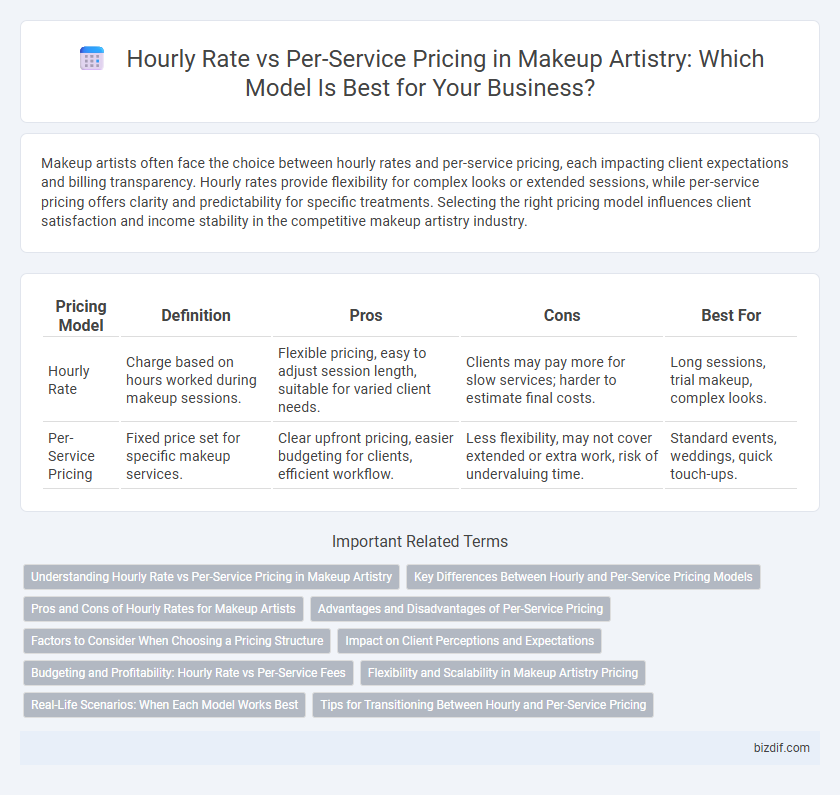Makeup artists often face the choice between hourly rates and per-service pricing, each impacting client expectations and billing transparency. Hourly rates provide flexibility for complex looks or extended sessions, while per-service pricing offers clarity and predictability for specific treatments. Selecting the right pricing model influences client satisfaction and income stability in the competitive makeup artistry industry.
Table of Comparison
| Pricing Model | Definition | Pros | Cons | Best For |
|---|---|---|---|---|
| Hourly Rate | Charge based on hours worked during makeup sessions. | Flexible pricing, easy to adjust session length, suitable for varied client needs. | Clients may pay more for slow services; harder to estimate final costs. | Long sessions, trial makeup, complex looks. |
| Per-Service Pricing | Fixed price set for specific makeup services. | Clear upfront pricing, easier budgeting for clients, efficient workflow. | Less flexibility, may not cover extended or extra work, risk of undervaluing time. | Standard events, weddings, quick touch-ups. |
Understanding Hourly Rate vs Per-Service Pricing in Makeup Artistry
Makeup artistry pricing strategies include hourly rates and per-service fees, each impacting client budgeting and artist income differently. Hourly rates offer flexibility for custom looks and extended sessions, while per-service pricing provides clear cost expectations for specific treatments like bridal makeup or photoshoot styling. Understanding the benefits and limitations of both models helps makeup artists optimize revenue and clients choose the best value for their beauty needs.
Key Differences Between Hourly and Per-Service Pricing Models
Hourly rates in makeup artistry offer flexibility by charging clients based on the actual time spent, ideal for unpredictable or complex projects requiring extended attention. Per-service pricing establishes a fixed cost for specific looks or treatments, providing clarity and budget predictability for clients seeking defined outcomes such as bridal makeup or editorial shoots. The choice between models impacts client expectations, artist workload, and revenue consistency, making it essential for professionals to assess project scope and client preferences when setting prices.
Pros and Cons of Hourly Rates for Makeup Artists
Hourly rates provide makeup artists with consistent compensation for time spent, ensuring pay regardless of project scope or complexity. This pricing method may deter clients seeking fixed budgets and complicate cost estimation for services requiring varying time investments. Hourly rates also risk undervaluing efficiency during quick jobs or overcharging for slower processes, impacting client satisfaction and competitive positioning.
Advantages and Disadvantages of Per-Service Pricing
Per-service pricing in makeup artistry offers clear advantages such as transparent costs for clients and tailored pricing based on the complexity of each service, enabling artists to charge accurately for specialized work like bridal makeup or airbrush application. Disadvantages include potential income inconsistency, as artists may face variability depending on client demand and the number of services booked, making financial forecasting challenging. This model demands careful service categorization and pricing strategy to balance profitability with market competitiveness in the beauty industry.
Factors to Consider When Choosing a Pricing Structure
When deciding between hourly rates and per-service pricing in makeup artistry, factors such as client preferences, project complexity, and time variability play crucial roles. Hourly rates offer flexibility for unpredictable sessions, while per-service pricing ensures clarity and predictability for standardized looks like bridal or editorial makeup. Evaluating local market trends, skill level, and desired income stability helps artists select the optimal pricing strategy.
Impact on Client Perceptions and Expectations
Hourly rate pricing in makeup artistry often leads clients to focus on time spent rather than outcome, potentially causing concerns about efficiency and value. Per-service pricing clearly defines costs for specific looks, setting precise expectations and simplifying decision-making for clients. Transparent pricing models enhance trust and satisfaction by aligning client perceptions with the artist's expertise and deliverables.
Budgeting and Profitability: Hourly Rate vs Per-Service Fees
Makeup artists must carefully evaluate budgeting and profitability when choosing between hourly rates and per-service fees, as hourly rates provide predictable earnings for extended sessions while per-service fees maximize revenue from varied, shorter bookings. Accurate cost analysis and time management enable artists to optimize pricing strategies that match client demand and workload fluctuations. Strategic pricing ensures sustainable income, balancing operational costs with competitive market positioning in the beauty industry.
Flexibility and Scalability in Makeup Artistry Pricing
Charging an hourly rate in makeup artistry offers flexibility by accommodating varying client needs and session durations, allowing artists to adjust prices based on time invested. Per-service pricing provides scalability, enabling clients to select specific treatments with clear upfront costs, which can streamline booking and payment processes. Combining both methods can optimize revenue by balancing predictable income with adaptable options for different project scopes.
Real-Life Scenarios: When Each Model Works Best
Hourly rates work best for complex makeup sessions like bridal or editorial shoots where time can vary significantly and customization is key, ensuring artists are fairly compensated for their detailed work. Per-service pricing suits straightforward applications such as standard party makeup or quick touch-ups that require consistent time and effort, providing clear costs for clients upfront. Real-life scenarios demonstrate that choosing between these models depends on session length, complexity, and client expectations to balance fairness and transparency.
Tips for Transitioning Between Hourly and Per-Service Pricing
When transitioning between hourly rates and per-service pricing in makeup artistry, evaluate the average time spent on common services to set competitive and profitable fees. Analyze client preferences and service complexity to determine which pricing model enhances transparency and satisfaction. Implement clear communication about pricing structure changes to build trust and facilitate a smooth adjustment for clients.
Hourly rate vs Per-service pricing Infographic

 bizdif.com
bizdif.com